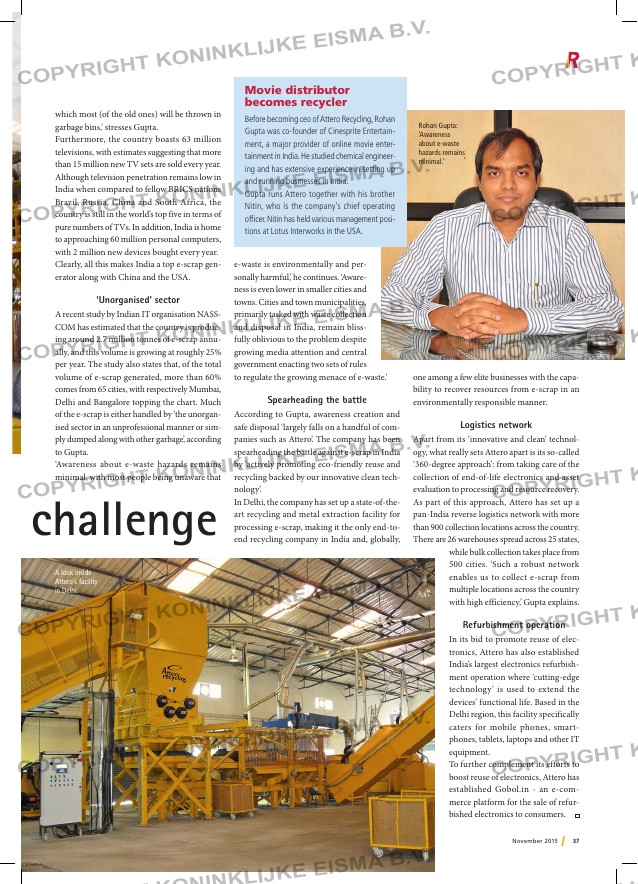Page 39 from: November 2015

37November 2015
which most (of the old ones) will be thrown in
garbage bins,’ stresses Gupta.
Furthermore, the country boasts 63 million
televisions, with estimates suggesting that more
than 15 million new TV sets are sold every year.
Although television penetration remains low in
India when compared to fellow BRICS nations
Brazil, Russia, China and South Africa, the
country is still in the world’s top five in terms of
pure numbers of TVs. In addition, India is home
to approaching 60 million personal computers,
with 2 million new devices bought every year.
Clearly, all this makes India a top e-scrap gen-
erator along with China and the USA.
‘Unorganised’ sector
A recent study by Indian IT organisation NASS-
COM has estimated that the country is produc-
ing around 2.7 million tonnes of e-scrap annu-
ally, and this volume is growing at roughly 25%
per year. The study also states that, of the total
volume of e-scrap generated, more than 60%
comes from 65 cities, with respectively Mumbai,
Delhi and Bangalore topping the chart. Much
of the e-scrap is either handled by ‘the unorgan-
ised sector in an unprofessional manner or sim-
ply dumped along with other garbage’, according
to Gupta.
‘Awareness about e-waste hazards remains
minimal, with most people being unaware that
e-waste is environmentally and per-
sonally harmful,’ he continues. ‘Aware-
ness is even lower in smaller cities and
towns. Cities and town municipalities,
primarily tasked with waste collection
and disposal in India, remain bliss-
fully oblivious to the problem despite
growing media attention and central
government enacting two sets of rules
to regulate the growing menace of e-waste.’
Spearheading the battle
According to Gupta, awareness creation and
safe disposal ‘largely falls on a handful of com-
panies such as Attero’. The company has been
spearheading the battle against e-scrap in India
by ‘actively promoting eco-friendly reuse and
recycling backed by our innovative clean tech-
nology’.
In Delhi, the company has set up a state-of-the-
art recycling and metal extraction facility for
processing e-scrap, making it the only end-to-
end recycling company in India and, globally,
one among a few elite businesses with the capa-
bility to recover resources from e-scrap in an
environmentally responsible manner.
Logistics network
Apart from its ‘innovative and clean’ technol-
ogy, what really sets Attero apart is its so-called
‘360-degree approach’: from taking care of the
collection of end-of-life electronics and asset
evaluation to processing and resource recovery.
As part of this approach, Attero has set up a
pan-India reverse logistics network with more
than 900 collection locations across the country.
There are 26 warehouses spread across 25 states,
while bulk collection takes place from
500 cities. ‘Such a robust network
enables us to collect e-scrap from
multiple locations across the country
with high efficiency,’ Gupta explains.
Refurbishment operation
In its bid to promote reuse of elec-
tronics, Attero has also established
India’s largest electronics refurbish-
ment operation where ‘cutting-edge
technology’ is used to extend the
devices’ functional life. Based in the
Delhi region, this facility specifically
caters for mobile phones, smart-
phones, tablets, laptops and other IT
equipment.
To further complement its efforts to
boost reuse of electronics, Attero has
established Gobol.in – an e-com-
merce platform for the sale of refur-
bished electronics to consumers.
Dialling in to India’s e-scrap challenge
Movie distributor
becomes recycler
Before becoming ceo of Attero Recycling, Rohan
Gupta was co-founder of Cinesprite Entertain-
ment, a major provider of online movie enter-
tainment in India. He studied chemical engineer-
ing and has extensive experience in setting up
and running businesses in India.
Gupta runs Attero together with his brother
Nitin, who is the company’s chief operating
officer. Nitin has held various management posi-
tions at Lotus Interworks in the USA.
A look inside
Attero’s facility
in Delhi.
Rohan Gupta:
‘Awareness
about e-waste
hazards remains
minimal.’



